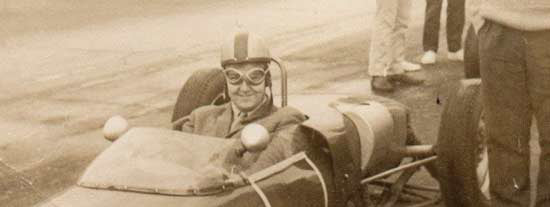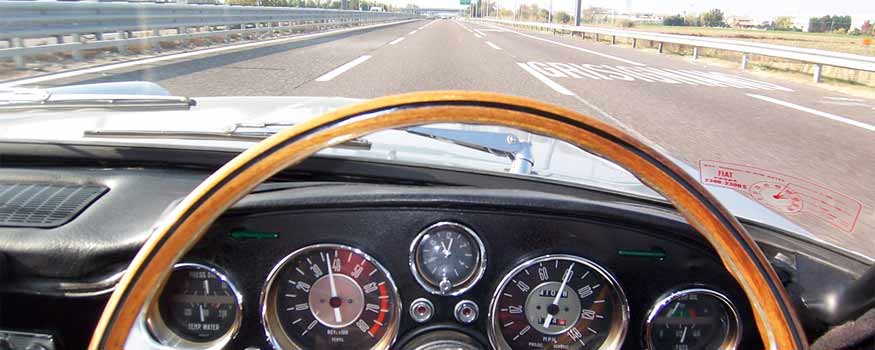
BRP’s Indianapolis Swan Song, part 2
By Ian Wagstaff
‘Indy fever is even visible in London as the BRP mechanics under Tony Robinson are building a couple of very nice semi-monocoque cars for Masten Gregory and Friend,’ wrote Henry N Manney in the influential US magazine, Road and Track. The cars, said the American, ‘looked very neat and solid, unlike some racing cars I could mention.’

Above: One hopes that Masten Gregory was merely referring to the fact that two BRP Indy cars were built! (Courtesy Tony Robinson)
The design of the new Indy cars was based on the experience BRP had gained building the monocoque Formula Ones and of working, before that, with the Lotus 18 and 24. The Grand Prix cars had given the team an idea of the way to go but it was treading on new ground when it came to the power and performance of the Ford engine, let alone the speeds that were likely to be reached at Indianapolis. Everything had to be ‘beefed up’ from the three Formula One cars. The way that BRP had built the latter was to first make mock-ups and the same process was used for the Indy cars. Using a jig bed that it had from its Grand Prix cars, the team placed mock-up bulkheads at the front, centre and rear. The mock-up engine and a gearbox casing were put in place and ‘we ended up with the physical dimensions,’ says Robinson. ‘We already knew Masten’s size as he had already driven for us. We did not know, initially, who the other driver was going to be. Eventually we were told that it would be Johnny Boyd who (at 5ft 11in) was taller than Masten so we decided on a compromise size for the cockpit, a bit too large for Masten and a bit too small for Boyd. We could not afford to sacrifice too much unused cockpit area as we had to carry so much fuel.’

Above: Masten Gregory signed this photo of himself for George Woodward…. (Courtesy George Woodward/IMS photo)
Initially, the team did not know if the car would be fuelled by petrol or methanol. If the latter, it would have to carry a full 75 gallons in its rubber fuel bags to avoid an extra pit stop. It also proved difficult to obtain precise fuel consumption figures on the Ford engine. Six weeks were spent designing a car capable of incorporating 75 gallons by making use of cowl tanks and pressure refuelling connectors. And then a change in the regulations stated that such tanks and pressure refuelling were banned. That meant a loss of a precious 10 gallons. Five of these were retrieved by extending the seat tank and making the car a little wider.

Above: ….as did Johnny Boyd. (Courtesy George Woodward/IMS photo)
There is a story attached to the fuel tanks, which were manufactured by Marston Excelsior. They could have been extremely expensive. However, Tony, aware that money was tight, appealed to the better nature of the supplier’s managing director John Harvey-Jones – later to become a noted business ‘trouble-shooter’ on television – who agreed to a reduction in cost to around £700.
‘Once we had manufactured the three bulkheads and tied the front and centre by two longitudinal bottom members, from there on we just had to bend up the internal shape of the cockpit area, drill it and clamp it to the front and centre bulkheads,’ says Robinson. ‘It was all basically straightforward. It looked very much like a Formula One car. We wanted to give it some nice cosmetic lines. The suspension was a beefed up version of what we used on the Formula One car. There was no point in us being too daring and experimental.’ Williams and Pritchard, which has been responsible for the body of the Lotus 18/22, made the body from a colossal sheet of 16 gauge NS4 aluminium alloy.

Above: Woodward (left) and Chapman stand over their charge. (Courtesy Steve Francis)
Masten Gregory was responsible for the supply of the engines and the ZF gearboxes. Gregory, who had yet to race at Indianapolis although he had practised there, chose the ZF over a box from Colotti. Drawings were initially sent for the gearbox, which were all in metric. As Woodward says, ‘We were still in feet and inches!’
When a mock-up engine arrived, Robinson, pleased that he had not yet had to make the decision, was astounded. The little gearbox appeared far too small for the V8 Ford engine. Ford, itself, had expressed a preference for the opposition and carried out over 1,000 miles of testing on a Colotti ‘box with the original Lotus 29 Indy car. However, ZF had strengthened the casing of its gearbox and Robinson was assured that it would do the job. In fact, two ‘boxes were originally going to be made available: a two-speed for the Indianapolis Motor Speedway and a five-speed which could be used at other circuits in the USAC (United States Auto Club) championship schedule. Manney suggested that this would also allow the car to be used in Formule Libre.
The first five-speed ‘box was promised for March 15. Twenty-four hours after, it had still not turned up. A phonecall was put through to ZF in Germany to ascertain what was happening. It appeared that the five-speed would not now be turning up until between April 20 and 25. Fair enough, that was required for later races but what about the two-speed for the Indianapolis 500? Ah, that would be delivered in June, not a good idea given that the race was scheduled to take place on May 31. Any idea of using a two-speed at ‘the Brickyard’ was abandoned and a second five-speed ordered with a prayer that it would be delivered on time. It was not an ideal situation; blanks could be fitted instead of real gears to reduce the number but the box would still weigh around 30lb more.
Delivery of the engines was even worse. It was discovered that they would be at least two weeks later. Given that such power units were sensitive to atmospheric conditions, Masten Gregory’s team decided not to have them shipped to the UK at all but to have them installed at the track. Testing the cars before they left England became out of the question. Thankfully, the existence of the mock-up engine and gearbox meant that such as piping, wiring and throttle linkage could be sorted out. A bell housing manufactured by Ford Advanced Vehicles for the Ford GT40 and modified to fit the BRP was also installed.
The delays in the delivery of the gearboxes slowed down completion of the cars. However, they were not the only components that were missing. There seemed to be a long delay between despatch of the Halibrand wheels from Los Angeles and their eventual arrival in Highgate. These were specifically designed for use at Indianapolis and made use of knock-on hubs and a five-pin drive rather than the splines to which BRP was more used.
Above: George Salih, chief mechanic on the BRPs for 1965, had been responsible for the 1957 and 1958 Indy 500-winning Belond AP Special. (Author)
Despite all these delays, Ken Gregory was able to boast that from the initial conversation with his namesake to the hand-over of the cars took five months. Eventually they were shipped to Indianapolis in the April where they were taken over by the organisation that had been established to run them by Bryant. Two of the mechanics were to be Woodward and Chapman, men from either end of the UK, the former from Yorkshire, the latter from Kent. However, they did not have the necessary licence from USAC to act as chief mechanics, so the experienced George and Howard Gilbert were appointed as such. Woodward also points out how he and Chapman were not, at the time, conversant with the intricate technicalities of qualifying for the 500. ‘It was a complicated procedure. If you did not wave your arm at the right point, you might be given a time you did not particularly want!’ George points out though, that he and Jim were initially uncomfortable with having to work with two Americans and not telling their colleagues that they would not be going to the USA after having built the cars. Over the years the Formula One team had become a tight knit unit and they were used to working with each other. ‘We were all the best of friends. It did not sit very easily with us, but we kept quiet for a while.’
It was only when Masten Gregory came round to paying for mechanics to travel to America that it was known that he only wanted George and Jim. Woodward thinks that Ken Gregory was against this to start with ‘but then perhaps the pound signs started going round.’ It is very possible that Ken was unhappy about the situation as he was loyal to his regular mechanics. The first the others knew of it was when a letter was noticed that had been left lying on a secretary’s desk but, says Woodward, ‘To their credit, they got down, pulled their weight and built the cars.’
George Salih, who had built the low 1957 and 1958 Indy 500-winning Belond AP Special, spent just one weekend at BRP’s Highgate factory. Cars Illustrated thought that Robinson might also attend the race but, other than his earlier brief appearance at the office to pick up the regulations, he was never to go to the Speedway. Throughout his career and beyond, he was never to see an IndyCar race.
‘We were up against time,’ recalls Woodward, ‘working seven days a week right up to going to Indy. As George remembers, he and Jim ‘were a bit knackered when we got to Indy.’ No doubt, so were the others who had to remain behind.
Click the following link for BRP's Indianapolis Swan Song, part 3
Click the following link for BRP's Indianapolis Swan Song, part 1
Books by Ian Wagstaff







Leave a comment
This site is protected by hCaptcha and the hCaptcha Privacy Policy and Terms of Service apply.